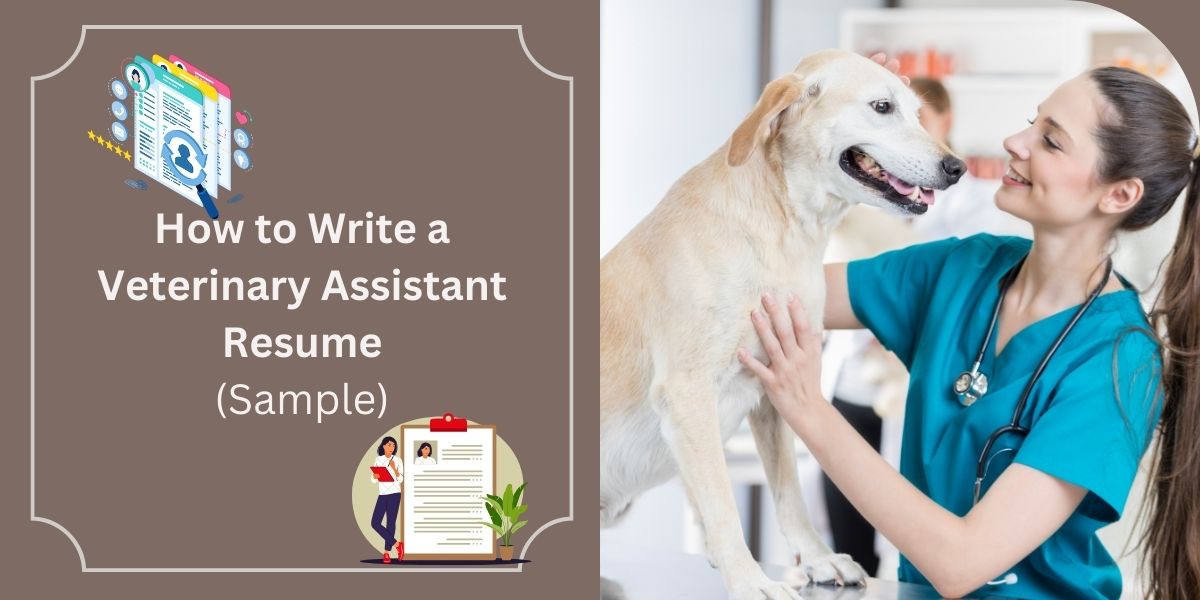Crafting a veterinary assistant resume is more than just listing skills and experiences. It’s about showcasing your passion for animal care and your ability to support veterinarians in providing exceptional healthcare.
As a veterinary assistant, you’ll play a vital role in ensuring the well-being of animals while also educating pet owners and maintaining a clean and organized clinical environment.
A veterinarian assistant resume should highlight your ability to assist licensed veterinarians with procedures like surgeries, radiographs, or emergency care. In this article, we will show you how to write a professional resume to land your next job.
What does a veterinary assistant do?
Veterinary assistants support veterinarians in a wide range of ways, including:
- Restrain and comfort animals during inspection or treatment.
- Feed, exercise, and occasionally wash pets.
- Administer prescriptions and vaccines, and help with lab work.
- Clean and sterilize the kennels, treatment rooms, and surgical equipment.
- Communicate compassionately and competently with human clients.
How to write a veterinary assistant resume
Follow these steps to write a resume for a veterinary assistant position:
1. Add a resume header with contact information
A resume header includes key details like your name and contact information. Mention your first and last name on the first line. Then, add your phone number, email address, and location on the next line.
If a hiring manager thinks your resume matches the job description, they may use your contact information to speak with you about your qualifications and their open role
2. Write an objective
In two or three sentences, highlight your strengths as a candidate. List your relevant skills, experience, and achievements as a veterinary assistant or in a similar role.
This informs hiring managers of your qualifications at the start of your resume. It also helps them understand your unique abilities and can help them determine whether you’re a strong job candidate.
3. List your work history
Create a section that shares your relevant experience as a veterinary assistant. Typically, a veterinary assistant has experience in the same role or another animal-related position.
For each role, include the job title, employer, employment dates, and your previous job duties. When you list your previous responsibilities, use strong action verbs, quantify data when possible, and highlight your soft and hard skills.
Make sure the duties you include help hiring managers see the value you might add to their company.
If you don’t have professional work experience, consider including volunteer positions or internships that relate to a veterinary assistant role. For example, veterinary assistants may have previous experience as animal shelter volunteer.
4. Share your relevant skills
In a separate section, mention your strongest and most relevant skills as a veterinary assistant. Include both soft and hard skills throughout this section.
Soft skills relate to your ability to interact with people, while hard skills refer to your technical abilities for the job. Here are some common skills you can include in a veterinary assistant resume:
- Communication
- Animal examination
- Collaboration
- Physical strength
- Animal behavior knowledge
- Time management
- Active listening
- Instructing
- Interpersonal
- Learning strategies
- Long-term care
- Physiology
- Planned health care treatment
- Science
- Systems Evaluation
5. Mention your academic history
Apart from learning about your professional experience, hiring managers typically want to know where you received your formal training for this profession.
Veterinary assistants often have a high school diploma or its equivalent. In some cases, they may have a certificate or associate degree, such as one in veterinary medicine.
Include any diplomas or degrees, the granting institution and, if you graduated within the past three years, the year you earned the credential.
6. List your certifications
Conclude your resume with a section for your relevant certifications. Though not required for this veterinary profession, a certification can help you develop your technical skills and help you appeal to hiring managers.
Include the name of each certification, along with the hosting organization and the year you received or renewed it.
Veterinary assistant resume sample template
While you may not really understand by reading the above steps, we have a veterinary assistant resume sample template to follow below:
[Your Name]
[Your Address]
[Email Address]
[Phone Number]
Objective:
I am a dedicated and compassionate veterinary assistant seeking to contribute my passion for animal care and clinical skills to [Veterinary Clinic/Hospital Name], where I can assist veterinarians in providing top-quality care to patients.
Professional Experience:
Veterinary Assistant
[Veterinary Clinic/Hospital Name] | [Location]
[Dates of Employment]
- Assisted veterinarians in medical procedures, including vaccinations, wound care, and surgical preparations.
- Managed patient intake, including recording medical histories, taking vital signs, and assisting with examinations.
- Maintained cleanliness and organization of examination rooms, surgical suites, and treatment areas.
- Provided compassionate care and comfort to patients during their stay at the clinic/hospital.
- Educated pet owners on proper animal care, medication administration, and post-operative instructions.
Animal Care Technician
[Animal Shelter/Rescue Organization Name] | [Location]
[Dates of Employment]
- Provided daily animal care, including feeding, grooming, exercise, and socialization.
- Assisted in medical treatments, such as administering medications and monitoring health conditions.
- Conducted behavioral assessments and implemented training programs to improve adaptability.
- Collaborated with veterinarians and animal care staff to ensure the well-being of animals in the facility.
- Participated in adoption events and outreach programs to promote responsible pet ownership.
Skills:
- Knowledge of animal behavior, anatomy, and common medical conditions.
- Proficiency in medical terminology and record-keeping.
- Ability to handle and restrain animals safely and compassionately.
- Strong communication and interpersonal skills with pet owners and team members.
- Experience with laboratory procedures, diagnostic imaging, and pharmacy operations.
- Commitment to maintaining a clean and sanitary environment for both patients and staff.
Education:
Associate Degree in Veterinary Technology
[College/University Name] | [Location]
[Year of Graduation]
Certifications:
- Certified Veterinary Assistant (CVA)
- CPR and First Aid Certification for Animals
- [Any other relevant certifications]
Conclusion
Creating an effective veterinary assistant resume requires highlighting key skills such as animal handling, medical assistance, client communication, and organizational abilities.
By optimizing your resume with relevant keywords and emphasizing your dedication to animal welfare, you can stand out as a strong candidate in the competitive veterinary healthcare field.




 Jobi.ng
Jobi.ng



